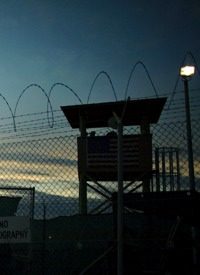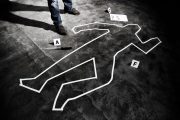
Mohamedou Ould Slahi of Mauritana had allegedly recruited some of the 9/11 highjackers and apparently underwent some of the worst torture at Guantanamo up to the time that the documents were written. Secretary of Defense Donald Rumsfeld personally approved his interrogation regimen, according to commanding Major-General Mike Dunlavey. A Pentagon Criminal Investigative Division (CID) report explained the approved torture regimen: “The plan included isolation, interrogations for up to 20 hours, the use of various types of sound, deprivation of light and auditory stimulu (whereby Slahi would at times be placed in a silent ‘white room’), removal of all comfort items, MRE-Only diet, forced grooming, and sleep adjustment. SOUTHCOM projected that the interrogations would take place over a period of 90 days, with JTF-GTMO to assess their effectiveness every 90 days.”
After three months of sleep deprivation, isolation, and sensory deprivation nearly identical to the “brain-washing” techniques used by Chinese communists on American POWs during the Korean war to elicit false confessions, U.S. interrogators turned the torture up a notch. Slahi was told that “beatings and physical pain are not the worst thing in the world,” and that much was the truth. He was already in a situation worse than physical beatings, as nearly all persons who have endured both physical torture and sensory deprivation have attested. But interrogators told him that he should “use his imagination to think of the worst possible scenario he could end up in,” adding that “he will very soon disappear down a very dark hole” where “his very existence would become erased” and “no one will know what happened to him and, eventually, no one will care.” Then interrogators created an elaborate ruse that gave Slahi the impression he was being transferred from Guantanamo in a confusing, five-hour boat ride.
The Pentagon CID report noted that another tortured detainee, Mohammad Kahtani, endured “stress positions” and that “Kahtani was checked daily by a doctor, and a medic was always present at the site during interrogations.” This may sound like medical professionals intervened in order to prevent abuse. But at Guantanamo and other U.S. interrogation prisons abroad, the role of doctors was to maximize the pain endured by the detainee while ensuring that life-threatening tortures didn’t end detainees’ lives.
An independent International Red Cross Committee report issued to the Bush administration in 2007 documented such conditions as hypothermia, legs swelled from prolonged “stress position,” and drowning (“waterboarding”) were employed where the doctors’ specific role was to bring the detainees to the edge of death (without going over the edge) again and again: “There was a direct role in monitoring the ongoing ill-treatment which, in some instances, involved the health personnel directly participating while certain methods were used.” The Red Cross flatly labeled treatment at Guantanamo “torture.”
Slahi and Kahtani’s torture regimen was unapologetically carried out with exacting cruelty, along with the torture of others, on direct orders from the Bush White House. But the military brass in charge of the facility soon found themselves being stabbed in the back by the politicians and under criminal investigation, with at least one major-general being Mirandized during a deposition.
Guantanamo commander Major-General Mike Dunlavey (2002 through 2004), a 30-year-veteran interrogator, noted that when he arrived at Guantanamo “virtually no one had a degree of expertise to deal with these people.” Particularly incompetent were military interrogators, Dunlavey said. “The military linguists were worthless. They came out of school and could order coffee, but they were getting smoked by the detainees.” And the commander selected for conducting interrogations by the White House was a rank amateur. Major-General Geoffrey Miller, Commanding General for the Joint Task Force in charge of interrogations at Guantanamo from November 4, 2002 through March 26, 2004, confessed in a deposition: “I am not an expert on detention or interrogation…. I have seen several hundred interrogations now. When I showed up at GTMO I had never witnessed one.”
Dunlavey and Miller explained that they were laden with interrogators who could not control themselves:
- “There was an interrogator that was [blacked out words] that had to be removed. He got into it with one of the detainees. It got out of control and he physically mishandled the detainee.”
- Another unnamed Lt. Col. reservist was a “closet alcoholic” who had to be removed.
- “We physically removed an FBI agent when he went across the desk at a detainee.”
- “An Article 15 was given to an interrogator for hosing down a detainee.”
- A female interrogator “took off her BDU shirt and inappropriately rubbed on the detainee.”
- One detainee was called a homosexual and “an interrogator forced [the detainee] to dance with a male interrogator.”
- And one problem with an interrogator is still classified: “We discovered our interrogator was [blacked out words]…. The tough part was he was our best interrogator. He was sent back for prosecution.”
The only positive was the presence of FBI interrogators. “I also had high faith the FBI was conducting proper interviews,” Dunlavey said, summarizing the FBI’s view as: “Physical abuse just does not work. Successful prosecution was their goal.” But Dunlavey’s goal was to extract intelligence using torture methods handed down directly from the secretary of defense, so “we had problems from the get go with the FBI,” even though “they had the best interrogators.”
Dunlavey and Miller also denied torture allegations in a sworn statement, even while they acknowledged “interrogations” equivalent to torture occurred.
Dunlavey claimed: “Physical torture does not work. It does not give you intelligence. Rapport, relationship dependency, the Koran, and the prayer beads gives intelligence. It has to be a dependency relationship.” He also stated: “The detainees were treated humanely. They had a high status of care…. Humane is who we are as the American military.”
But “humane” was the opposite of what U.S. military interrogators were at Guantanamo and elsewhere, and Dunlavey and Miller claimed not to know about a number of torture procedures:
Stress Positions: Dunlavey denied that “short-shackling,” chaining a detainee on short shackles to the floor so they are unable to sit up or stretch out for long periods of time, occurred as part of interrogation techniques: “Chaining the detainee in a fetal position is not a normal procedure to be used in interrogation. If a detainee leaped at an interrogator, it might have been used for security. It is not a normal procedure. The interrogators were instructed not to touch the detainees. They were to leave it to the guards.” But the International Committee on the Red Cross report later documented that this procedure was commonly used at Guantanamo. And the 2004 Pentagon CID report confirmed that several detainees were short-shackeled in stress positions.
Use of Dogs: Major-General Miller, who was Mirandized (advised of his rights) at the beginning of the CID interview, claimed that the use of military dogs in interrogation never occurred: “Military working dogs. No, not in interrogations. They were at Camp X-ray for Al Katani. They were used for detention, not interrogation.” But Major-General Dunlavey contradicted Miller, noting, “Dogs were there to intimidate…. Using dogs is equal to the Fear Up technique.” The CID investigation concluded dogs were used.
The CID report also documented a number of other “approved” torture methods, including hypothermia and sexual humiliation. The CID report admitted that “on several occasions between November 2002 and January 2003, interrogators would adjust the air conditioner to make [one prisoner] uncomfortable.” Another was subject to “hot and cold temperatures to make him uncomfortable.” But “uncomfortable” is simply a way of trivializing a torture to create hypothermia without causing death. Regarding sexual humiliation, one detainee “was forced to wear a woman’s bra and had panties placed on his head during the course of the interrogation.” Others were subject to frequent “strip searches” and “nudity.”
Much of the abuse that Slahi endured was also endured by Mohammad Kahtani, including 52 days of sleep deprivation. He was “interrogated for 20 hours a day with 4 hours of sleep from 23 November 2002 until 15 January 2003.” Even during his four hours of sleep, Guantanamo interrogators would blast music and recorded screams into his cell, and occasionally flash bright red lights, in order to interrupt his sleep. Kahtani also endured five months of solitary confinement during the sleep deprivation, as he was “separated from the detainee population from 8 August 2002 until 15 January 2003.”
The U.S. military hardly showed that it was “humane” at Guantanamo as Major-General Dunlavey claimed, but the CID report and other documents declassified last week prove that the arch-criminals responsible for torture at Guantanamo didn’t wear a military uniform.
Photo: AP Images



